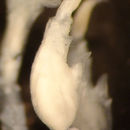en
names in breadcrumbs


Length: 3-16mm. Head and body smooth except for antero-lateral projections on pereonites 3 and 4. Antenna 1 equals cephalon plus pereonite 2, flagellum shorter than peduncle articles 1 + 2; antenna 2 shorter than antenna 1 peduncle, flagellum with swimming setae. Gnathopod 1 with serrate grasping margin to propodus and dactylus. Gnathopod 2 propodus less than twice as long as it is broad, and longer than basis; palm with enormous medial-distal poison spine and proximal grasping spine and accessory spine. Dactylus heavy, tapered and curved in distal one-third, inner-margin denticulate. Basis attached posteriorly on pereonite 2. Gills large, oval. Pereopods 5 to 7 short; propodus with proximal grasping spines. Female differs in gnathopod 2 attached anteriorly on pereonite 2, propodus shorter than arm and having minute poison spine.
California, Oregon, Washington, British Columbia, Alaska; Akkeshi Bay, Japan.
Caprellid, "Ghost" or "Skeleton" shrimps, so called for their skeletal appearance. Amphipod crustaceans, easily distinguished by the elongate stick-like body form and reduction of the abdominal appendages. Head is generally fused with pereonite 1. Pereopods on first 2 segments (pereonites) are most flexible and called gnathopods; gnathopods 2 being the largest, used in defense, feeding and substrate attachment. In many species pereopods 3 and 4 may also be reduced or absent. Gills on pereonites 3 + 4, rarely on pereonite 2. Pereopods 5 - 7 much smaller than 1 + 2, used for clinging to the substratum. In females, brood plates (öostegites) develop on pereonites 3 + 4. Much remains to be learnt about their biology, ecology and in many cases changing distributions.
4-6m. Attached to many substrates: hydroids, bryozoans, compound ascidians, algae and eelgrass
Intersex individuals found. Occasionally with epiphytic diatom: Isthmia nervosa. Described as the most common species in Pacific north-west America (Laubitz 1970). Tolerant to a wide variety of temperature and salinity. Adaptation to different ecological conditions may explain variation in body structure.
National Museum of Natural History, Washington DC: (NMNH) 40140